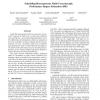Free Online Productivity Tools
i2Speak
i2Symbol
i2OCR
iTex2Img
iWeb2Print
iWeb2Shot
i2Type
iPdf2Split
iPdf2Merge
i2Bopomofo
i2Arabic
i2Style
i2Image
i2PDF
iLatex2Rtf
Sci2ools
ISCA
2012
IEEE
2012
IEEE
Scheduling heterogeneous multi-cores through performance impact estimation (PIE)
Single-ISA heterogeneous multi-core processors are typically composed of small (e.g., in-order) power-efficient cores and big (e.g., out-of-order) high-performance cores. The effectiveness of heterogeneous multi-cores depends on how well a scheduler can map workloads onto the most appropriate core type. In general, small cores can achieve good performance if the workload inherently has high levels of ILP. On the other hand, big cores provide good performance if the workload exhibits high levels of MLP or requires the ILP to be extracted dynamically. This paper proposes Performance Impact Estimation (PIE) as a mechanism to predict which workload-to-core mapping is likely to provide the best performance. PIE collects CPI stack, MLP and ILP profile information, and estimates performance if the workload were to run on a different core type. Dynamic PIE adjusts the scheduling at runtime and thereby exploits fine-grained time-varying execution behavior. We show that PIE requires limited ...
| Added | 28 Sep 2012 |
| Updated | 28 Sep 2012 |
| Type | Journal |
| Year | 2012 |
| Where | ISCA |
| Authors | Kenzo Van Craeynest, Aamer Jaleel, Lieven Eeckhout, Paolo Narváez, Joel S. Emer |
Comments (0)

